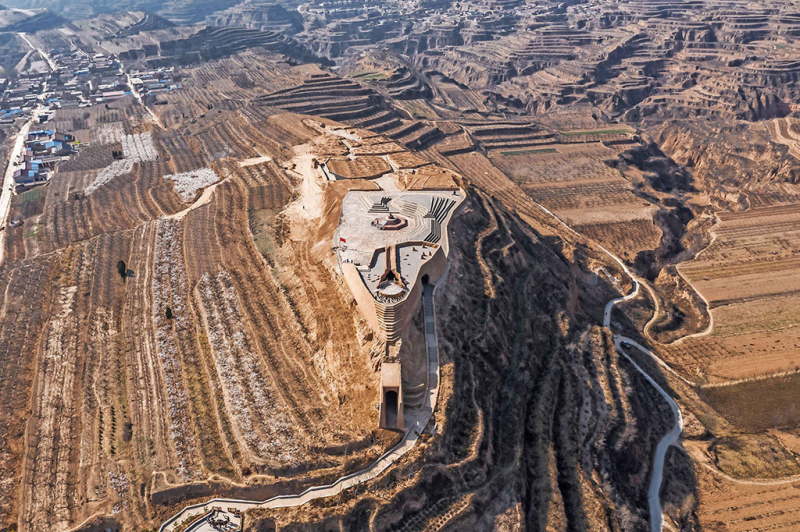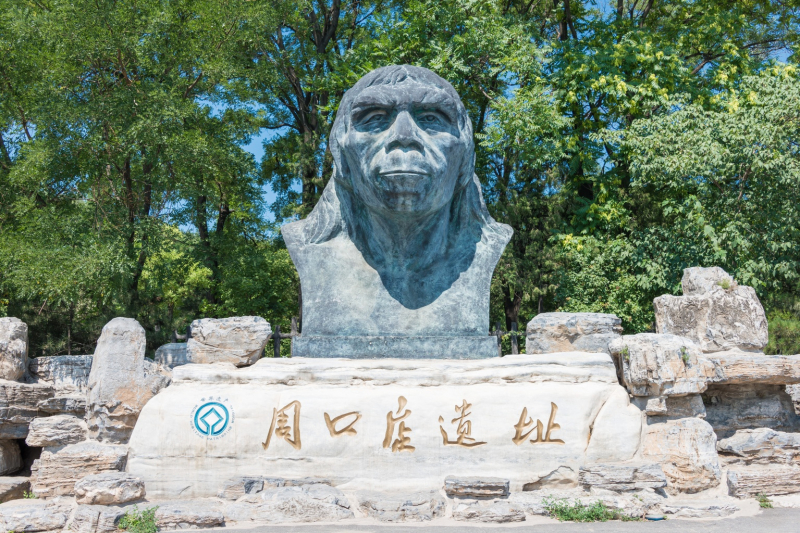Top 4 Most Famous Paleolithic Sites in China
Today, the study of paleolithic cultures is the source for archaeologists to better understand the evolutionary process of ancient humans. That helps us to ... read more...know exactly where the human race originated. China, a country with thousands of millions of years of history, has long been considered an important site for archaeologists to explore the ancient world. The diversity and complexity between the two traditional Stone Age cultures of southern and northern China have provided further insights into the intellectual development and survival of the ancient Chinese. Today, China has discovered a lot of old ruins of human ancestors. Below is a list of Famous Paleolithic Sites in China that Toplist would like to introduce to readers.
-
A Paleolithic Archaeological Site called Shangchen may be found in Lantian County, Shaanxi Province, China, about 25 kilometers south of Weinan. It was found in 1964, and excavations took place in 2004 and 2017.
Shangchen is named after Shangchen Village in Yushan Town. The archaeological site is situated on the rock wall of a ravine in the Loess Plateau. Archaeologists identified Shangchen as one of China's Paleolithic Sites because they discovered that all the larger rocks in the loess sediments were brought in by humans or other animals.A 2018 research used magnetic fields to date stone tools discovered at the site. The site's oldest artifact-bearing stratum dates back to 2.12 million years ago, while the youngest is just 1.26 million years old, indicating that the region was inhabited for at least 850,000 years. A Loess with an age of 2.12 Ma precedes the first fossils of Eurasian archaea by around 300,000 years. Deer and cow bones, as well as several artifacts, were discovered among the bones of the animals. The lowest strata of Shangchen remained inaccessible as of 2018 since the region was "actively farmed," thus it is possible that even earlier remains have not been found.
The Homo erectus specimen, now referred to as the Lantian, was found in Lantian County in 1964. The oldest fossil discovered by archaeologists is a cranium that is 1.15 million years old. Geologist Zhu Zhaoyu and other researchers returned to the location in 2001 and found another skull that was 1.63 million years old. The discoveries are remarkable because they surpass Dmanisi in Georgia's Caucasus area, which was previously known, and are one of the oldest indications of Homo outside of Africa after Masol in India. It dates back 1.85 million years and is the earliest Paleolithic site outside of Africa. Additionally, it dates back 1.7 million years earlier than the Yuankou, the earliest fossilized hominid discovered in East Asia. Further exploring the region around the fossil discovery, Zhu's team found stone tools at Shangchen, which is only a little more than three miles away, buried deep inside a trench. The site was then extensively explored and excavated between 2004 and 2017 by a team under the direction of British paleontologist Robin Dennell, whose results were released in March in the journal Nature's July 2018 edition. As a result, a total of 96 stone tools were discovered at Shangchen, including fragments, points, and cores that belonged to 17 different artifact classes. However, dating of the sediments is only possible by paleomagnetic methods because the Shangchen site lacks volcanic minerals like the African sites.
To conclude, Shangchen Paleolithic Archaeological Site:
- was found in 1964 in Ha Long, Lantian County, Shaanxi Province, China, about 25 kilometers south of Weinan.
- the artifacts were discovered in 17 strata from 1.26 Ma (palaeosol S15) to 2.12 Ma indicating that the region was inhabited for at least 850,000 years.
- contains Lantian fossils dating from 1.15 million years to 1.63 million years old.
- a total of 96 stone tools were discovered, including fragments, points, and cores.
- archaeologists have not been able to reach the lowest levels of Shangchen since 2018.

The 2.12-million-year-old stone artifact at the Shangchen site - Photo:sci.news 
One of the 2.1 million-year-old artifacts, right, recovered from a gully in western China (left) suggest that hominins may have left Africa far earlier - Photo: nytimes.com -
A Paleolithic Archaeological Site called Xihoudu may be found in China's Shanxi Province. On a terrace 170 meters above river level on the east bank of the Yellow River in Xihoudu village, researchers found this site in 1959. There were three excavations: one each in 1961, 1962, and 2005. It is the earliest known Paleolithic Cultural Site in China, dating back 1.8 million years. At the site, 32 different stone tools were discovered in total.
Xihoudu is situated in the center of the Yellow River on the sunny side of Zhongtiao Mountain in the northwest of Ruicheng County in southern Shanxi Province. It is thought by archaeologists that this region's ancient climate was moderate and home to a variety of aquatic vegetation. There are some extinct species such as the Paleoloxodon Namadicus (ancient elephant), Sus Lydekkeri, Père David deer, Shanxi woolly rhinoceros, Equus Sanmeniensis (ancient horse), Gazella Blacki (ancient antelope), and fish. Therefore, such a natural environment is ideal for human survival and reproduction.
In all, 32 stone artifacts, including stone cores, pieces, and stone tools, were uncovered at the Xihoudu site in the 1960s. They belong to the group of the oldest stone tools found in China. Archaeologists claim that the technique used to create the stone implements at this location is still rather primitive. The primary raw material is vibrant quartz stone, with smaller amounts of veined quartz and volcanic rock also present. In 2005, more than 1,500 stone items and animal fossil samples were discovered during the course of more than 50 days of excavation. There are a lot of high-quality and standardized stone items with minor wear and evident traces.
Along with stone tools, there are a number of artifacts that have been cut or scraped, as well as burnt animal bones, horns, and teeth that are thought to be evidence of human fire use. In Zhoukoudian Beijing, between 500,000 and 700,000 years ago, the fire was first used by the ancient Chinese, and this indicates that 1.1 million years ago, at the Xihoudu site, the fire was first used.
The scholarly community has struggled to completely acknowledge the Xihoudu ruins after they were discovered by archaeologists. Whether the discovered stone tools were manufactured by hand or not is a matter of debate. Researchers like Pei Wenzhong and Zhang Senshui asserted that it was hard to verify whether the stone tools were man-made and that they were most likely the result of river collisions. However, specialists from the Shanxi Province Institute of Archeology think that continuing to excavate to get more fresh knowledge is the best method to settle these conflicts. The issue of dating has been overcome thanks to the progress of archaeological research, which has led to the identification of artificial stone product traces. The Xihoudu site is now among the premier Paleolithic archaeological sites in the world.
The Xihoudu Cultural Relics Protection Group was established by the Ruicheng District People's Government in 1983. Later, the Shanxi Provincial People's Government designated the Xihoudu Cultural Relic Site as a cultural relic conservation organization. province in 1986. Two years later, Xihoudu Ruins received the title of National Key Culture for the third time, Monument Protection Unit. The Xihoudu Ruins Exhibition Hall, with a total construction area of about 130 square meters, was established in 2013 by the Cultural Relics Board of Ruicheng County, Shanxi Province to store unearthed cultural artifacts.
In sum, Xihoudu paleolithic site:
- was found in 1959 in China's Shanxi Province.
- was the earliest known Paleolithic Cultural Site in China, dating back 1.8 million years.
- 32 different stone tools were discovered in total at the site including stone cores, pieces, and stone tools in the 1960s.
- more than 1,500 stone items and animal fossil samples were discovered during the course of more than 50 days of excavation in 2005.
- 1 million years ago, the fire was also first used at the Xihoudu site.
- Monuments protection and display areas in Xihoudu were established to store artifacts found over the years.

abitare.it 
archello.com -
Some of the earliest paleolithic remains in East Asia may be found in Xiaochangliang, which is well known for the stone tools that have been found there. It is situated in Yangyuan County, Hebei, China's Nihewan Basin. In Chinese, this location's name translates to "long narrow hilltop".
The location is situated on the Nihewan Plateau, some 120 kilometers northwest of Beijing, the capital of China. This plateau was formerly a lake that was there between 40,000 and 30,000 years ago, but it vanished as the environment got drier. According to geological research, tectonic and climatic variations in the region have caused the height of the lake's water level to fluctuate rapidly during the last few million years, with shifts of hundreds of meters possible. Consequently, this location offers the creature an appropriate environment. Animal remains found in the area suggest that a certain species of creature thrived on savannas dotted with small forests.
Xiaochangliang was found in 1978 during a geological survey. However, as the soil material is unsuitable for radioisotope dating, other less accurate dating techniques must be utilized. The site is thought to be one million years old based on the style of the stone tools and how they were used, as well as a tentative Paleozoic dating in 1985. Then, in 1995 measurements backed by earth springs and new magnetic field measurements indicate ages of 1.67 million years and less than a million years, respectively. Age of 1.34 million years is determined by the third measurement (in 2001). The most recent measurement was done in 2012, and the time frame is 1.36 million years.
804 stone artifacts and several animal bones were found during the excavation that was conducted in 1978. Thousands of stone items and animal bones were found at the site over the years 1990 to 1997 when it was further researched. Only in 1998, when a global excavation team was assembled, did the most significant scientific study take place. Their excavation tactics make use of the most recent research instruments as well as modern archaeology's standard documentation practices. 901 stone items that seem to have been created by humans have been found since the excavation in 1998. They are mostly made of quartzite and volcanic rock. Stones that were obviously employed as tools in daily crafts have been discovered via microscopic investigations. Tools are divided into four categories: saws for cutting, knives for hewing or engraving, scrapers for scraping, and drills for punctures or other food processing-related jobs. Animal components, including raw meat, skins, and body parts, are removed, processed, and chopped. These markings are all found on stone slabs. In addition, the excavations turned up 3,291 pieces of animal bone and teeth. The dentition has allowed scientists to identify several animal taxa, including the civet cat Viverra, the extinct elephant Palaeoloxodon, the horse's Hipparion and Equus, the bison, and the rhinoceros.
In short, Xiaochangliang:
- is located in Yangyuan County, Hebei, China's Nihewan River basin, and is considered one of the earliest Paleolithic archaeological sites in East Asia.
- was found in 1978 during a geological survey.
- due to the complex physical topography, researchers had difficulty dating the site. The most recent measurement was made in 2012, with a time frame of 1.36 million years.
- in 1978, excavations found 804 stone artifacts and several animal bones.
- 901 seemingly man-made stone items have been found since the 1998 excavation. They are mostly made of quartz, and volcanic rock and are used as everyday craft tools.
- 3,291 animal bones and teeth were also found in that year (1998).

The Lithic Assemblages in Xiaochangliang - Photo: journals.plos.org 
The Lithic Assemblages in Xiaochangliang - Photo: journals.plos.org -
On the North China Plain, the Peking Man site at Zhoukoudian is a Pleistocene site. The location is situated at the intersection of the Yanshan Range and the North China Plain, about 42 kilometers southwest of Beijing. According to scientists, the abundant water supply and natural limestone caves in this area contributed significantly to the creation of an optimized survival environment for early humans in China.
In 1921, the site of Pekingese was first discovered by Johan Gunnar Andersson, but it was not until Otto Zdansky's survey that he unearthed two human teeth in 1921 and 1923. Later scientists also discovered fissures in the Middle Pleistocene sediments containing limestone with about 45 individuals, as well as stone-cutting tools and scales.
Scientists have so far uncovered ancient human bones, cultural artifacts, and animal fossils from 23 places at the site that date from 5 million years to 10,000 years ago. These include the bones of Homo Erectus Pekinensis, which existed between 700,000 and 200,000 years ago in the Middle Pleistocene, archaic Homo sapiens, who lived between 200,000 and 100,000 years ago, and Homo sapiens sapiens, who appeared around 30,000 years ago. Over 100,000 stone tool pieces, hundreds of animal fossils, and evidence of Pekingese fire use, such as fireplaces, ash deposits, and burned bones, were all found in the same period.
Zhoukoudian is very significant in a global context since significant hominid sites identified in mainland Asia indicate an evolutionary cultural chain. In addition to serving as a unique reminder of the prehistoric human cultures that formerly existed in mainland Asia, it also serves as a valuable tool for studying and reconstructing the early history of humans. The discovery of hominid bones in Zhoukoudian and subsequent studies in the 1920s and 1930s sparked public attention and challenged the up to that moment largely accepted timeline of Human history. As a result, the scientific research and excavations at the Zhoukoudian site have contributed significantly to the history of both world science and archaeology.
It is very important to preserve and preserve the values of the Beijing Man Site in Zhoukoudian. The location where the ancient human fossils were discovered, the ancient humans' habitat, as well as the excavation and scientific research conducted there in the 1920s and 1930s, have all been preserved in their entirety and provide information about the exact cost and significant scientific value of the property. Unfortunately, the excavation was halted and severely damaged when the Sino-Japanese War broke out in 1937. The previously found fossils of Sinanthropus Pekinensis have been disassembled or lost. Following the war, some human fossils discovered during fresh digs helped to partially make up for these losses. The conservation initiatives for the site have strictly complied with the guidelines for conserving cultural assets in terms of design, material, methods, and technology. Thus, the Peking Man Site at Zhoukoudian has kept its scientific relevance.
In sum, the Peking Man Site at Zhoukoudian:
- is situated at the intersection of the Yanshan Range and the North China Plain, about 42 kilometers southwest of Beijing.
- an optimized survival environment for early humans in China.
- fissures in the Middle Pleistocene sediments containing limestone with about 45 individuals, as well as stone-cutting tools and scales.
- scientists uncovered ancient human bones, cultural artifacts, and animal fossils from 23 places at the site that date from 5 million years to 10,000 years ago including the bones of Homo Erectus Pekinensis, archaic Homo sapiens, and Homo sapiens sapiens.
- have contributed significantly to the history of both world science and archaeology.

Zhoukoudian - Photo: whc.unesco.org 
Peking Man Site at Zhoukoudian - travelchina.org.cn
























